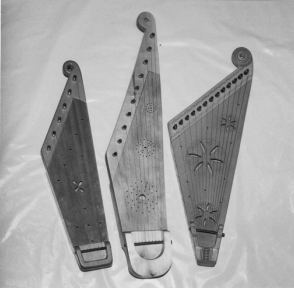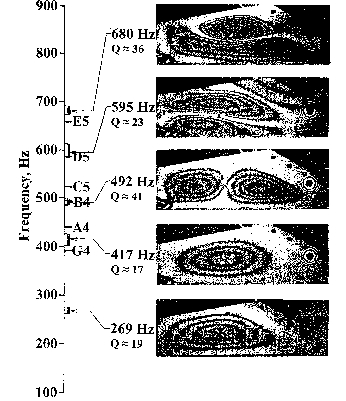Andres Peekna - innmech@wi.rr.com
Innovative Mechanics, Inc.
5908 North River Bay Road
Waterford, WI 53185-3035
Thomas D. Rossing - Rossing@physics.niu.edu
Physics Department
Northern Illinois University
DeKalb, IL 60115
Popular version of paper 4pMU6
Presented Thursday afternoon, May 27, 2004
147th ASA Meeting, New York, NY
The Baltic psaltery ia a plucked-string instrument, and is known in Finland
as kantele, in Estonia as kannel, in Latvia as kokle, in Lithuania as kankles,
and in northwestern Russia as wing-shaped gusli. In its archaic form, it had
a limited range, 5 to 13 strings, usually tuned diatonically, though the lower
strings were sometimes tuned as bourdons, several tones lower than the other
strings. The soundbox was hollowed from a single block of wood to which the
wooden soundboard was attached. Because of its mode of construction, the archaic
form is called the carved Baltic psaltery. No two instruments were exactly alike.
During the 19th century, the archaic Baltic psaltery was replaced by larger
instruments influenced by central European zithers having much greater tonal
range. Starting in the middle of the 20th century, however, the archaic carved
version enjoyed a healthy revival. Three carved Baltic psalteries in this study
are shown in the photograph below.
 |
Vibrational modes of several historic Baltic psaltery have been recorded by
means of holographic interferometry. Several vibrational modes of a six-string
kannel constructed by the first author, along with the tunings of the six strings,
are shown in the figure below. The pictures shown are, in effect, contour maps
of the changing elevations of the vibrating soundboard.
The vertical bars at the arrowheads are rough measures of the width of each
peak at half the power level of the peak.
 |
The experiments on the instruments reported in this paper suggest that a successful
carved Baltic psaltery should have a maximum number of resonances (modes) with
its tuning range, with good coupling between the strings and the soundbox. The
experiments also suggest that a successful instrument should have a strong resonance
between its keynote and the tone above.